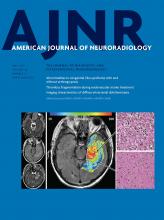Index by author
Zander, D.A.
- Head and Neck ImagingYou have accessTrochlear Groove and Trochlear Cistern: Useful Anatomic Landmarks for Identifying the Tentorial Segment of Cranial Nerve IV on MRIP.M. Bunch, H.R. Kelly, D.A. Zander and H.D. CurtinAmerican Journal of Neuroradiology May 2017, 38 (5) 1026-1030; DOI: https://doi.org/10.3174/ajnr.A5117
Zhang, B.
- EDITOR'S CHOICEPediatric NeuroimagingYou have accessHindbrain Herniation in Chiari II Malformation on Fetal and Postnatal MRIU.D. Nagaraj, K.S. Bierbrauer, B. Zhang, J.L. Peiro and B.M. Kline-FathAmerican Journal of Neuroradiology May 2017, 38 (5) 1031-1036; DOI: https://doi.org/10.3174/ajnr.A5116
The authors examined the neuroimaging findings with a focus on hindbrain herniation and ventricular size in fetuses with open spinal dysraphism and compared them with postnatal imaging features in groups undergoing prenatal-versus-postnatal repair. Thirty-two of 102 (31.3%) fetuses underwent in utero repair of open spinal dysraphism; 68.6% (70/102) underwent postnatal repair. Of those who underwent prenatal repair 81.3% (26/32) had resolved cerebellar ectopia postnatally. Of those who had severe cerebellar ectopia (grade 3) that underwent postnatal repair, 65.5% (36/55) remained grade 3, while 34.5% (19/55) improved to grade 2. They conclude that most fetuses who undergo in utero repair have resolved cerebellar ectopia postnatally.
Zhang, S.
- Adult BrainOpen AccessIpsilateral Prominent Thalamostriate Vein on Susceptibility-Weighted Imaging Predicts Poor Outcome after Intravenous Thrombolysis in Acute Ischemic StrokeX. Zhang, S. Zhang, Q. Chen, W. Ding, B.C.V. Campbell and M. LouAmerican Journal of Neuroradiology May 2017, 38 (5) 875-881; DOI: https://doi.org/10.3174/ajnr.A5135
Zhang, X.
- Adult BrainOpen AccessIpsilateral Prominent Thalamostriate Vein on Susceptibility-Weighted Imaging Predicts Poor Outcome after Intravenous Thrombolysis in Acute Ischemic StrokeX. Zhang, S. Zhang, Q. Chen, W. Ding, B.C.V. Campbell and M. LouAmerican Journal of Neuroradiology May 2017, 38 (5) 875-881; DOI: https://doi.org/10.3174/ajnr.A5135
Zimmer, C.
- EDITOR'S CHOICENeurointerventionYou have accessRisk of Thrombus Fragmentation during Endovascular Stroke TreatmentJ. Kaesmacher, T. Boeckh-Behrens, S. Simon, C. Maegerlein, J.F. Kleine, C. Zimmer, L. Schirmer, H. Poppert and T. HuberAmerican Journal of Neuroradiology May 2017, 38 (5) 991-998; DOI: https://doi.org/10.3174/ajnr.A5105
The authors evaluated the potential relationship between thrombus histology and clot stability in 85 patients with anterior circulation stroke treated with thrombectomy. The number and location of emboli after retrieving the primary thrombus, the number of maneuvers, and TICI scores were evaluated. H&E and neutrophil elastase staining of retrieved clots was performed. An inverse correlation between maneuvers required for thrombus retrieval and the number of distal and intermediate emboli was observed. Younger patients were at higher risk for periprocedural thrombus fragmentation. Bridging thrombolysis tended to be associated with fewer maneuvers but more emboli. They conclude that younger age, easy-to-retrieve thrombi, and bridging thrombolysis may be risk factors for periprocedural thrombus fragmentation. Higher neutrophil levels in the thrombus tissue were related to an increased risk of periprocedural thrombus fragmentation.
Zins, M.
- You have accessReply:J. Hodel, R. Blanc, E. Kalsoum, M. Zins and X. LeclercAmerican Journal of Neuroradiology May 2017, 38 (5) E33; DOI: https://doi.org/10.3174/ajnr.A5131
Zwart, C.M.
- Head and Neck ImagingYou have accessMRI-Based Texture Analysis to Differentiate Sinonasal Squamous Cell Carcinoma from Inverted PapillomaS. Ramkumar, S. Ranjbar, S. Ning, D. Lal, C.M. Zwart, C.P. Wood, S.M. Weindling, T. Wu, J.R. Mitchell, J. Li and J.M. HoxworthAmerican Journal of Neuroradiology May 2017, 38 (5) 1019-1025; DOI: https://doi.org/10.3174/ajnr.A5106








